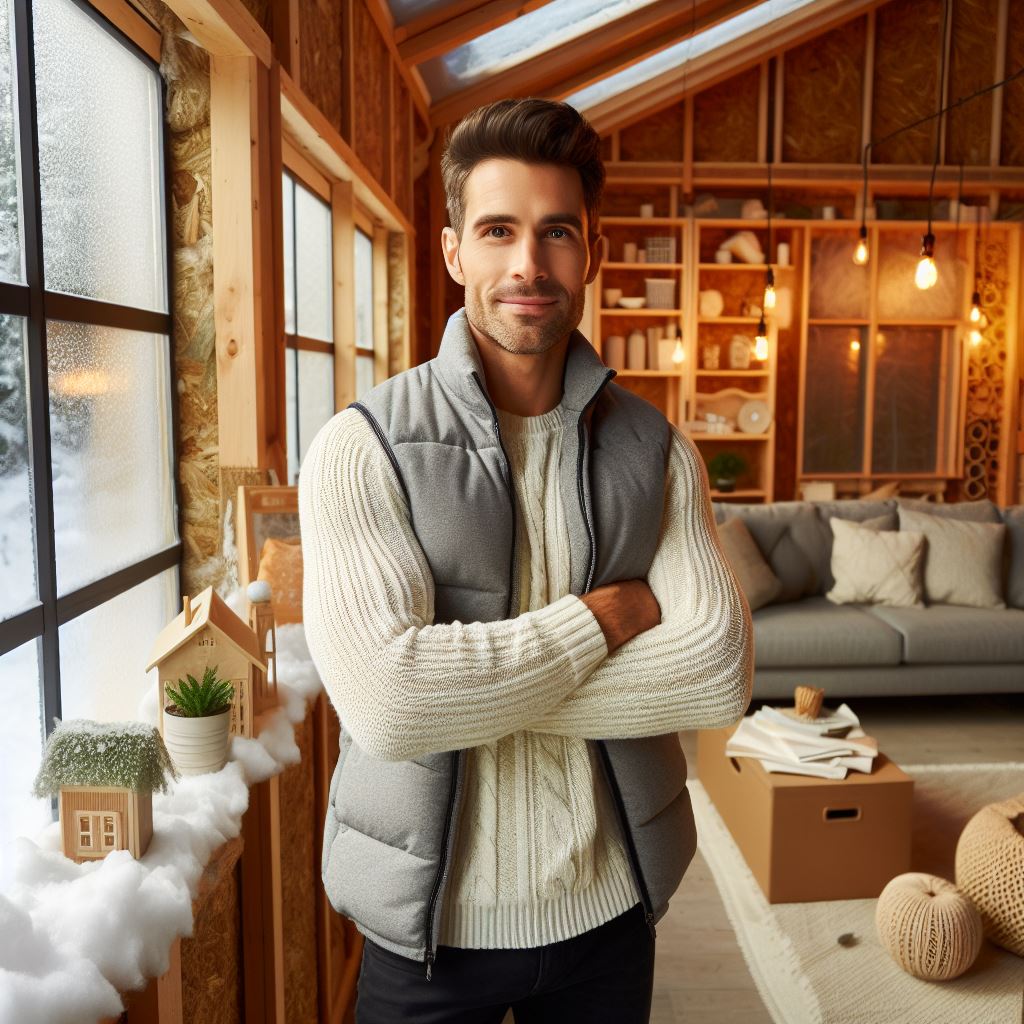Introduction
As winter approaches, it becomes crucial to prepare and protect your rental property from the harsh elements.
Neglecting winterization can lead to significant damage, costing you time, money, and unnecessary stress.
By taking the necessary steps to winterize your rental property, you can ensure its longevity and the comfort of your tenants throughout the colder months.
Winterizing your rental property is not just an option but an essential responsibility as a landlord.
Failing to do so can result in frozen pipes, burst water lines, and damaged heating systems.
These issues can not only inconvenience your tenants but also lead to costly repairs and potential legal liabilities.
By properly winterizing your property, you demonstrate your commitment to maintaining a safe and habitable living environment.
Winterizing your rental property offers numerous benefits, including preventing potential damage and saving money in the long run.
By insulating pipes and sealing any air leaks, you can avoid freezing and bursting pipes, which can cause extensive water damage.
Additionally, ensuring your heating system is in optimal condition can help you avoid costly repairs or replacements.
By taking proactive measures to winterize your property, you not only protect your investment but also save on expenses and reduce the chances of tenant disputes.
In fact, winterizing your rental property is a crucial aspect of property management.
By recognizing the importance of winterization and understanding its benefits, you can safeguard your property, save money, and maintain strong relationships with your tenants.
Stay tuned for the next post, where we will discuss specific tips and steps for effectively winterizing your rental property.
Exterior Preparation
Winter is approaching, and it’s time to start preparing your rental property for the chilly season.
Transform Your Real Estate Decisions
Unlock personalized real estate insights crafted just for you. Get actionable advice designed to amplify your success.
Get StartedBy taking the necessary steps to winterize your property, you can prevent potential damage and ensure the comfort of your tenants.
In this section, we will focus on the essential exterior preparations that need to be done. Let’s get started!
Clean gutters and downspouts
Cleaning the gutters and downspouts should be high on your priority list.
Leaves, twigs, and debris tend to accumulate, especially during the fall season.
Clogged gutters can lead to water overflow, which can damage the roof, siding, foundation, and even the interior of the property.
Regular cleaning will prevent costly repairs.
Inspect and repair roofing
Inspecting the roofing is crucial before the winter sets in.
Look for missing or damaged shingles, loose flashing, or any signs of leaks.
Addressing these issues promptly will help protect your property from water damage and potential mold growth.
Consider hiring a professional if you are not comfortable with roof inspections.
Seal gaps and cracks
Sealing gaps and cracks is an effective way to keep the cold air out and the warm air in during the winter months.
Look for areas around windows, doors, and the foundation where air might escape.
Use weatherstripping or caulking to seal those gaps.
This simple step will enhance energy efficiency and save on heating costs.
Showcase Your Real Estate Business
Publish your company profile on our blog for just $200. Gain instant exposure and connect with a dedicated audience of real estate professionals and enthusiasts.
Publish Your ProfileTrim trees and branches near the property
Trimming trees and branches is essential to prevent any potential hazards during winter storms.
Ice accumulation on branches can cause them to break and damage the property or injure individuals.
Hire a professional arborist if the trimming requires working at heights or dealing with large trees.
Drain and shut off outdoor water sources
Draining and shutting off outdoor water sources is crucial to prevent freezing and bursting pipes.
Water expands when it freezes, and this expansion can cause pipes to crack or burst.
Disconnect hoses, drain them, and store them properly. Consider insulating outdoor faucets to provide extra protection.
Take necessary precautions to prevent ice dams
Last but not least, taking preventative measures against ice dams can save you from significant trouble.
Ice dams occur when snow on the roof melts and refreezes at the eaves, causing water to back up and potentially damage the roof and interior.
Ensure proper insulation and ventilation in the attic to minimize the risk of ice dams.
In short, by following these essential exterior preparation tips, you can minimize the risk of property damage and inconvenience to your tenants during the winter season.
A well-prepared rental property will not only retain its value but also keep your tenants happy and comfortable.
Stay tuned for the next section covering interior preparations!
Read: Lawn and Garden Upkeep for Property Managers
HVAC Systems
During the winter season, it’s crucial to take necessary steps to winterize your rental property effectively.
One aspect that requires special attention is the HVAC (Heating, Ventilation, and Air Conditioning) system.
By properly caring for your HVAC system, you can ensure it functions efficiently during the colder months and prevent potential issues.
Here are some essential tips to winterize your HVAC system:
Schedule a professional HVAC inspection and maintenance
Firstly, it is highly recommended to schedule a professional HVAC inspection and maintenance service.
A trained technician can thoroughly examine the system, identify any underlying problems, and perform necessary repairs or adjustments.
This proactive approach can prevent unexpected breakdowns and ensure your HVAC system operates optimally throughout the winter.
Replace air filters
In addition to professional maintenance, another crucial step is to regularly replace air filters.
Dirty filters can impede airflow, reducing the efficiency of your HVAC system and potentially causing damage.
By installing clean air filters, you not only improve indoor air quality but also help your system run smoothly.
Check and clean vents, registers, and ducts
Furthermore, it’s important to check and clean vents, registers, and ducts.
These components can accumulate dust, debris, and even mold over time.
By inspecting and cleaning them, you can ensure proper airflow, minimize allergens, and improve system performance.
Insulate exposed pipes
To protect your plumbing system from freezing temperatures, it’s essential to insulate exposed pipes.
Areas such as basements, crawl spaces, and attics are more susceptible to freezing pipes.
By adding insulation to these exposed areas, you can prevent potential bursting and avoid significant water damage.
Set thermostat to an appropriate temperature to prevent freezing
Lastly, setting the thermostat to an appropriate temperature is critical in preventing freezing and ensuring comfort for your tenants.
Showcase Your Real Estate Business
Publish your company profile on our blog for just $200. Gain instant exposure and connect with a dedicated audience of real estate professionals and enthusiasts.
Publish Your ProfileIt is recommended to maintain a consistent temperature of at least 55°F, even when the property is vacant.
This will help prevent freezing, protect your plumbing system, and avoid costly repairs.
All in all, winterizing your rental property’s HVAC system is essential for a comfortable and trouble-free winter season.
By scheduling professional inspections, replacing air filters, cleaning vents and ducts, insulating exposed pipes, and setting an appropriate thermostat temperature, you can mitigate potential issues and ensure the optimal performance of your HVAC system.
Prioritizing these tasks will not only benefit your tenants but also protect your investment in the long run.
Read: Plumbing Fixes Every Property Owner Should Master

Plumbing and Water Systems
As the winter chill sets in, it’s crucial to safeguard your rental property against the potential havoc that freezing temperatures can wreak on plumbing and water systems.
Follow these essential tips to ensure your pipes and water-related components withstand the winter months unscathed.
Insulate Pipes in Unheated Areas
Cold temperatures can be particularly harsh on exposed pipes, especially those in unheated areas such as basements, attics, or crawl spaces.
Invest in quality pipe insulation to create a protective barrier that helps prevent freezing.
This simple step can save you from the headache and expense of dealing with burst pipes.
Insulate Water Heater and Exposed Tanks
Your water heater and other exposed tanks are vulnerable to the cold.
Wrap them with insulating blankets to maintain a consistent temperature and prevent heat loss.
This not only helps in energy conservation but also ensures that your water heating systems operate efficiently during the winter.
Drain and Flush Water Heaters
Before the winter freeze takes hold, take the time to drain and flush your water heaters.
This process removes sediment buildup, enhancing the unit’s efficiency and prolonging its lifespan.
It also reduces the risk of corrosion, which can be exacerbated in colder conditions.
Shut Off Exterior Faucets and Drain Hoses
Outdoor faucets and hoses are susceptible to freezing and bursting.
Disconnect hoses, drain any remaining water, and shut off the exterior faucets from inside to prevent water from lingering in the pipes.
This small step can prevent significant damage to your plumbing system.
Consider Installing a Water Leak Detection System
Investing in a water leak detection system adds an extra layer of protection to your property.
These systems can identify and alert you to potential leaks before they escalate into more significant problems.
Early detection can save you from costly repairs and water damage.
By implementing these measures, you’ll be taking proactive steps to winterize your rental property’s plumbing and water systems.
This not only protects your investment but also ensures a comfortable and trouble-free living environment for your tenants throughout the winter months.
Read: Handling Tenant Repair Requests Efficiently
Indoor Preparations
Inspect windows and doors for drafts
Preparing your rental property for the winter season is essential to ensure the comfort and safety of your tenants.
The cold weather can cause various issues, such as drafts, energy inefficiency, and potential hazards.
By taking the time to winterize your property, you can save on energy costs and reduce the risk of winter-related damages.
In this section, we will discuss the necessary indoor preparations to keep your rental property in top shape during the winter months.
Showcase Your Real Estate Business
Publish your company profile on our blog for just $200. Gain instant exposure and connect with a dedicated audience of real estate professionals and enthusiasts.
Publish Your ProfileAdd weatherstripping and caulk if necessary
One of the first things you should do is inspect the windows and doors for drafts.
These drafts can significantly impact the indoor temperature and make it difficult to maintain a warm and cozy environment.
If you identify any drafts, it is important to add weatherstripping and caulk to prevent cold air from entering and warm air from escaping.
This simple step can make a noticeable difference in the energy efficiency of your rental property.
Insulate attics, crawl spaces, and basements
Another crucial indoor preparation is to insulate attics, crawl spaces, and basements.
These areas are prone to heat loss, and insufficient insulation can result in cold spots and high energy bills.
Consider adding insulation to these spaces to create a thermal barrier and improve overall temperature control.
Not only will this benefit your tenants, but it will also help you save on heating costs throughout the winter season.
Test smoke detectors and carbon monoxide detectors
In addition to insulation, it is vital to test the smoke detectors and carbon monoxide detectors in your rental property.
With the increased use of heating systems and fireplaces during winter, it is crucial to ensure that these safety devices are in proper working condition.
Test each detector and replace batteries if necessary to provide early detection of any potential hazards.
Have a plan for snow removal and maintaining walkways
Planning for snow removal and maintaining walkways is also essential to prevent accidents and injuries.
Clear pathways from snow and ice promptly to provide safe access for your tenants.
Consider hiring a professional snow removal service or establishing a clear arrangement with your tenants regarding their responsibility for snow removal.
By having a plan in place, you can avoid legal liabilities and promote the well-being of your tenants.
To sum up, taking proactive steps to winterize your rental property is crucial for a comfortable and safe living environment.
Inspecting windows and doors, adding weatherstripping and caulk, insulating key areas, testing detectors, and planning for snow removal are all essential tasks to complete before the winter season arrives.
By investing time and effort into these indoor preparations, you can ensure that your rental property remains in excellent condition throughout the colder months.
Read: Hiring Contractors: What Every Landlord Should Know
Tenant Education
Provide tenants with winter maintenance responsibilities
Winterizing your rental property is not just the landlord’s responsibility.
It is important to educate tenants on their own winter maintenance responsibilities.
Inform them about tasks such as clearing sidewalks, removing snow from entrances, and keeping heating systems in working order.
By sharing these responsibilities, you ensure that the property is well-maintained throughout the winter season.
Tips for preventing frozen pipes and reducing energy costs
Frozen pipes can result in costly damages, so it’s essential to educate tenants about preventing this issue.
Advise them on keeping the heat on during extremely cold weather, insulating pipes, and letting faucets drip to prevent freezing.
Additionally, share energy-saving tips like using programmable thermostats and sealing drafts to reduce energy costs during winter.
Remind tenants of the importance of reporting maintenance issues promptly
Prompt reporting of maintenance issues is crucial during the winter months.
Remind tenants that even minor issues such as leaks or drafts can lead to bigger problems if left unaddressed.
Encourage open communication so that you can address these issues promptly and prevent further damage to the property.
Provide emergency contact information for maintenance requests
In case of emergencies, it is vital to provide tenants with the necessary contact information for maintenance requests.
Showcase Your Real Estate Business
Publish your company profile on our blog for just $200. Gain instant exposure and connect with a dedicated audience of real estate professionals and enthusiasts.
Publish Your ProfileClearly communicate how to reach you or the property management team during after-hours or weekends.
This ensures that tenants can report urgent maintenance issues promptly, leading to timely resolutions and minimizing further damage.
By educating your tenants about these winter maintenance responsibilities and providing them with the necessary information, you can create a collaborative atmosphere for maintaining the property during the winter season.
Insurance and Liability
As the winter season approaches, ensuring your rental property is adequately protected from potential damages is crucial.
One key aspect of this preparation involves a thorough review of insurance coverage to safeguard against winter-related issues.
Here are essential tips to consider when addressing insurance and liability concerns during the colder months.
Review Insurance Coverage for Winter-Related Damages
Begin by evaluating your current insurance policy to confirm that it adequately covers potential damages associated with winter weather.
Check for provisions related to frozen pipes, ice dams, and other cold-weather risks.
If necessary, consider adjusting your policy or obtaining additional coverage to address specific winter-related concerns.
Communicate with Tenants about Their Insurance Responsibilities
Open communication with your tenants is essential.
Clearly convey the importance of tenants having renters insurance to protect their personal belongings in case of unforeseen events, including winter-related incidents.
Ensure they understand the limitations of your property insurance and emphasize the need for individual coverage.
Inform Tenants of Their Liability for Slip-and-Fall Accidents
Winter weather often brings icy surfaces, increasing the risk of slip-and-fall accidents.
Make sure tenants are aware of their responsibilities when it comes to maintaining safe walkways.
Provide guidelines for snow and ice removal and highlight their liability for accidents that occur due to negligence in maintaining these areas.
Consider Requiring Renters Insurance for Added Protection
To enhance overall protection, consider making renters insurance a mandatory requirement for all tenants.
This ensures that each tenant has a personal safety net in place, reducing potential disputes over property damage during the winter months.
Clearly outline this requirement in lease agreements and provide tenants with resources to obtain affordable renters insurance.
By addressing insurance and liability concerns in winter, you not only protect your property but also establish a proactive and responsible relationship with your tenants.
This comprehensive approach contributes to a safer and more secure rental environment throughout the winter season.
Conclusion
As winter approaches, ensuring that your rental property is adequately prepared is crucial for both the longevity of your investment and the safety and comfort of your tenants.
In this comprehensive guide, we’ve explored essential tips for winterizing your rental property.
Let’s recap these key points and emphasize the importance of proactive maintenance.
Essential Tips
- Inspect and Seal Windows and Doors: Drafts can significantly impact energy efficiency. Inspect windows and doors for any gaps or cracks, and seal them to prevent heat loss.
- Check and Insulate Pipes: Frozen pipes can lead to costly repairs. Insulate exposed pipes and, if necessary, consider installing heat tape to keep them warm during freezing temperatures.
- Maintain Heating Systems: Regularly service heating systems, clean filters, and ensure they are in optimal condition. This not only enhances energy efficiency but also prevents unexpected breakdowns during the winter months.
- Roof and Gutter Maintenance: Clear gutters of debris to prevent ice dams. Inspect the roof for any damaged or missing shingles, addressing issues promptly to avoid leaks.
- Landscaping Prep: Trim trees and branches to prevent damage from heavy snow and ice. Store outdoor furniture to prevent damage and make snow removal easier.
- Emergency Preparedness: Equip the property with essential winter emergency supplies, such as rock salt, shovels, and ensure tenants are aware of emergency protocols.
- Communicate with Tenants: Keep an open line of communication with your tenants. Encourage them to report any issues promptly, so you can address them before they become major problems.
Proactive Maintenance
Proactive maintenance is the key to avoiding costly repairs and ensuring the well-being of your property and tenants.
By taking these winterization steps before the first snowfall, you’re not only protecting your investment but also demonstrating a commitment to tenant satisfaction.
Make Winterization a Priority
In the end, winterizing your rental property is not just a seasonal chore; it’s a strategic investment in the longevity of your property and the safety of your tenants.
Proactive winterization measures can save you from potential headaches and expenses down the line.
As a responsible landlord, prioritize winterization to safeguard your investment and create a warm, secure living environment for your tenants.
Remember, a little preparation now can go a long way in ensuring a smooth and stress-free winter season.




